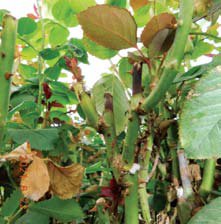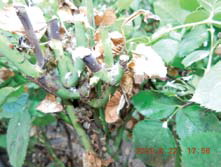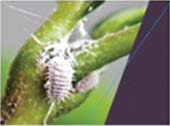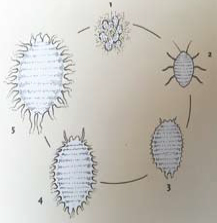Mealybugs pose a serious threat to growers in warmer climates as they can significantly reduce the productivity and yield of greenhouse crops. But lessons-learnt from greenhouse rose farms in Kenya demonstrate that it is possible to manage Mealybugs when the right tactics are deployed, such as early intervention supported by an effective scouting system, writes Edwin Kiptarus and Simon Kihungu
 Mealybugs have taken on a renewed significance with the recent arrival and rapid spread in Kenya of the Papaya mealybug, Paracoccus marginatus. Although not the same species as the Coffee mealybug, Planococcus kenyae, generally found on roses in Kenya, both are quarantine pests that have the potential to spread viruses along fresh cut flower pathways. Other Species of Mealybugs that affects ornamentals are: Common examples include the long tailed mealybug (Pseudococcus longispinus), which has characteristically long waxy filaments that protrude from the end of the abdomen, and the obscure mealybug (Pseudococcus viburni), which also has waxy filaments, but they are much shorter in comparison to the longtailed mealybug. Citrus mealybug (Planococcus citri), lacks any waxy filaments and has a gray stripe that extends the length of the body. The differences are shown in the image below:
Mealybugs have taken on a renewed significance with the recent arrival and rapid spread in Kenya of the Papaya mealybug, Paracoccus marginatus. Although not the same species as the Coffee mealybug, Planococcus kenyae, generally found on roses in Kenya, both are quarantine pests that have the potential to spread viruses along fresh cut flower pathways. Other Species of Mealybugs that affects ornamentals are: Common examples include the long tailed mealybug (Pseudococcus longispinus), which has characteristically long waxy filaments that protrude from the end of the abdomen, and the obscure mealybug (Pseudococcus viburni), which also has waxy filaments, but they are much shorter in comparison to the longtailed mealybug. Citrus mealybug (Planococcus citri), lacks any waxy filaments and has a gray stripe that extends the length of the body. The differences are shown in the image below:
Now more than ever, rose growers in the global cut flower trade need to keep track of the Mealybug situation and stay alert to the pest’s potential to spread to other markets. The Australian government reports that they have seen a steady rise of the pest over the last thirty years, with one-fifth of Mealybug interceptions on cut flowers and foliage, most of those were found on roses.
In the past, strong miticides used to manage the spread of spider mites were also effective at controlling the spread of Mealybugs and other pests. However, recent developments in pest management have resulted in pesticides being replaced by biological controls, and this has allowed Mealybugs to develop at uncontrollable rates. The warm temperatures of greenhouses also contribute to the Mealybug problem, as they are ideal conditions for crawlers to hatch. Once the immature scale crawlers emerge, Mealybugs can quickly spread to new plant parts and new hosts.
 Left untreated, Mealybugs can severely affect crop productivity, in terms of quality and quantity, as they produce a toxic saliva that interrupts plant growth. Unlike other crop pests, they hide in the crevices between branches and the underside of plant leaves and steps. This means their rapid development often escapes detection until it is too late to contain the spread. The bugs’ ability to avoid detection means it is hard to begin the required aggressive investment in control and eradication measures, especially as the pests don’t show up in post-harvest figures.
Left untreated, Mealybugs can severely affect crop productivity, in terms of quality and quantity, as they produce a toxic saliva that interrupts plant growth. Unlike other crop pests, they hide in the crevices between branches and the underside of plant leaves and steps. This means their rapid development often escapes detection until it is too late to contain the spread. The bugs’ ability to avoid detection means it is hard to begin the required aggressive investment in control and eradication measures, especially as the pests don’t show up in post-harvest figures.
1. Detection is key during the initial stages
A widespread Mealybug outbreak in the greenhouse can be avoided if you detect the pest early and take immediate action to contain the infestation. If allowed to spread, Mealybugs can become extremely difficult to eliminate due to their high reproduction rates – adult females can lay up to 600 eggs and reach damaging population levels quickly. To avoid this development, an indepth knowledge of the insect’s biology is crucial to early scouting efforts. Plant material needs to be checked for white cotton-like substances and sticky honeydews – clear signs that Mealybugs are present. If you miss this step, Mealybugs can produce large amounts of honeydew that supports the growth of black sooty mould, which interferes with plant respiration and transpiration. Plants infested with root mealybugs that go unnoticed can serve as a source for further spread to healthy plants, as these mealybugs easily move with water by leaching through drain holes in pots and then crawling into adjacent potted plants, where they become further established on the roots.
2. Keep it clean with cultural and mechanical controls – good greenhouse hygiene can keep the unwanted pest at bay
But more is required during the initial stages of Mealybug intervention. When introducing crops to growing areas, you should thoroughly inspect all plant materials to protect clean areas of the greenhouse from infestation. During the early stages of crop development, it is essential to raise an alarm at the sight of Mealybugs so that management is informed and can take immediate steps to prevent a widespread infestation in the greenhouse.
To manage an early infestation, it is key to practice good greenhouse hygiene right from the initial stages of crop development. For instance, debris needs to be regularly swept away from the greenhouse floor, as this tends to be a hotspot for Mealybug egg sacs. Growers should also avoid the tendency to over-water and over-fertilize the crop, as plants with high nitrogen levels and soft growth attract Mealybugs.
 Unwanted material such as weeds, dead foliage, and hanging leaves should also be cut to allow the crop to open up during the early stages of plant development. This increases the level of coverage and can improve the effectiveness of intervention methods, such as spraying, that might be used in later stages. Critical greenhouse hygiene measures also require a combination of cultural and mechanical controls to prevent the spread of infestation. For instance, you can protect clean areas of the greenhouse with the immediate removal of affected plants, crop and weed debris, and other plant parts. If agrobacterium tumefaciens sets in, growers need to monitor the rose crop for any fresh crown galls, as Mealybugs tend to hide inside and suck on the gall juice. On the detection of Mealybugs, you will need to dispose of the galls straight away and follow this step with a disinfection of the contaminated area. This way growers can significantly minimize Mealybug build-up and reduce the chances of re-infection. However, physical contact with infested plants should be kept to a minimum as Mealybugs easily adhere to clothing and implements.
Unwanted material such as weeds, dead foliage, and hanging leaves should also be cut to allow the crop to open up during the early stages of plant development. This increases the level of coverage and can improve the effectiveness of intervention methods, such as spraying, that might be used in later stages. Critical greenhouse hygiene measures also require a combination of cultural and mechanical controls to prevent the spread of infestation. For instance, you can protect clean areas of the greenhouse with the immediate removal of affected plants, crop and weed debris, and other plant parts. If agrobacterium tumefaciens sets in, growers need to monitor the rose crop for any fresh crown galls, as Mealybugs tend to hide inside and suck on the gall juice. On the detection of Mealybugs, you will need to dispose of the galls straight away and follow this step with a disinfection of the contaminated area. This way growers can significantly minimize Mealybug build-up and reduce the chances of re-infection. However, physical contact with infested plants should be kept to a minimum as Mealybugs easily adhere to clothing and implements.
3. Time for intervention? Start young – map for hotspots
Given that mealybugs can be found on various parts of the plant like the roots, the crop beddings, the crown galls, it is recommend that you drench a systemic insecticide to take care of the unseen infestation.
As Mealybugs can be hard to eradicate from the crop, you will need to follow up with early intervention tactics. It is key to start this intervention when Mealybugs are in the crawler stage and have yet to develop their white wax. For smaller spots, spot spraying is necessary.
High volume spraying to achieve good coverage of the infected area may only be necessary where the infestation is widespread. But regardless of the volume deemed appropriate, you need to target the Mealybugs in their hiding areas to disturb them from their colonies. At this stage an accurate mealybug map is essential to guide scouts to the hotspots where you need to target intervention.
4. Follow up with a rinse and repeat – high volume chemical spray
Despite initial success in disturbing them from their colonies, Mealybugs can continue to be a problem. We find a twopronged approach extremely effective at this stage. First, you can spray soapy water or detergent onto the plants to desiccate and crack the waxy layer of the Mealybugs.
To target the Mealybugs, you will need a high-water volume and a suggested size 16 or 18 nozzle should help with effective coverage. During this step, growers need to direct the spray of soapy water or detergent on the hard leaves to avoid scorching the younger and less developed leaves.
Secondly, follow with a chemical spray with a pH between 5.0 and 6.0 to effectively curb the spread of the Mealybug infestation. Recommended chemical sprays can include systemic chemicals such as Acephate, Imidacloprid, Spirotetramat, Sulfoxaflor, and Acetamiprid.
To achieve widespread coverage, growers should apply the chemical spray two or three hours after the crop has been washed with soapy water or detergent. For cases where the Mealybug infestation is well-established, weekly or semi-weekly intervals between sprays is suggested for effective management. When you have the best control for Mealybugs using the right pesticides, it is important that you achieve a good coverage and use the right volumes and pressure.
 5. Guarantee long-term sustainability with biological controls
5. Guarantee long-term sustainability with biological controls
To meet the ever-increasing demand for sustainable pest management, growers can incorporate biological controls into their long-term Mealybug strategies. The introduction of natural Mealybug enemies – such as parasitic wasps, ladybird beetles, and lacewings – can be a real game changer in pest management as worldwide production of these predators and parasitoids starts to increase. In particular, the predatory ladybird beetle, Cryptolaemus montrouzieri can feed on Mealybug eggs from the beginning of their larvae stage.
This development helps growers reduce the population density of the pest. Growers can achieve a similar outcome if they place pheromone traps around their greenhouses, especially in Mealybug hotspots, to attract the winged males. The traps are an effective and sustainable measure to disrupt further reproduction.
The use of biological insecticides, which are a sustainable alternative to chemical pesticides, can also be a viable and effective way for growers to manage Mealybug infections in the long-term. Insecticides such as Neem Oil are a relatively new biological control method, but this does not discredit their effectiveness.
In recent years, the use of insecticides is gaining importance due to their potential to prevent the chances of a Mealybug resurgence. In particular, many Integrated Pest Management companies are continuing to develop biopesticides that minimize the development of resistance in key insect pests and protect non-target biodiversity — this has the potential to significantly alter Mealybug control strategies in the future.
Incorporating new control methods into pest management helps in the battle against an insatiable pest.
Industrial growers need to meet the challenges of Mealybugs head on to protect crop productivity in greenhouses. This is where investing in an accurate and effective scouting system will help you achieve a successful long-term pest management.
While early intervention methods such as the use of undiluted alcohol, soapy water, and chemical sprays can be critical in reducing the size of the infestation, most sprays do not give the contact needed to eradicate the Mealybugs entirely. This is why a team of scouts armed with the knowledge and a reliable system to detect infestations early on is key to immediate intervention and will help growers win the battle against the insatiable pest.
